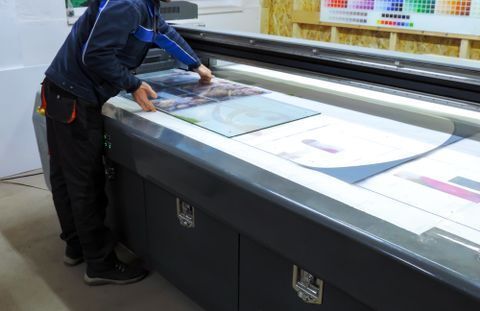November 15 , 2022

Printing is one of the most important tools in the marketing communications mix because it allows brands to reach their target audiences with physical, tangible, enduring messaging materials that can be distributed to audiences locally, regionally and nationally.
Ultraviolet (UV) printing is a printing method that is popular among sign makers, advertising agencies, and retailers. But what is UV printing, and how does it differ from other printing processes?
From a technical perspective, UV printing involves exposing ink—typically paper or plastic—to UV light to produce images on the surface of those materials. This process is called "photopolymerization,” leading printed materials to more durable while also saving energy in the production process.
What is UV Printing? And How Does It Work?
UV printing cures ink using UV lamps in less than a second, and the light source can either be an LED or a laser. You can use the process to print on almost any surface, including paper, plastic, glass, and metal.
Sophisticated technology with precision ink placement is mounted behind print head nozzles. When you direct the printer to print, these components flex and eject precise quantities of ink onto the print media.
This method gives fine control over the printer’s ink delivery, allowing better print quality, color density, and finish.
The process starts by placing your design onto the material you want to print. Then it is exposed to UV light for a specific amount of time. The exposure period depends on the ink used in the printing process.
Advantages of UV Printing
There are five advantages of UV printing.
UV printing is environment-friendly
UV ink is applied to a UV-sensitive photopolymer which is cured by UV light. The process leaves no waste or hazardous chemicals, making it an environment-friendly printing method.
UV printers also use thinner ink layers than other technologies, which results in less paper per page. Since UV paper is typically made from recycled materials, this further reduces the overall carbon footprint.
Other than helping the environment, it’s an opportunity for businesses to promote their use of environmentally friendly processes.
UV printing can avoid abrasion
Printed material is commonly exposed to wear and tear. UV printing can be used when you don’t want your design to get damaged. It’s especially important for long-term marketing campaigns like signage and wall signs that aim to reach a wider audience because you want to promote your products effectively through eye-catching designs that don’t have defects.
UV printing is faster
UV printers use a special kind of ink that reacts to UV light. This allows for a much faster print process, as the ink dries almost instantly after it's applied. Traditional printing methods can require more drying time, depending on the paper used.
UV printing provides higher productivity
Because UV printers are extremely fast,productivity can be higher than with other forms of printing.
Instead of using one printer and waiting for the first job to dry before you start printing again, you can use multiple printers simultaneously and keep going without stopping.
Your business might be handling several marketing campaigns to promote different products, so you will want to ensure that the process runs as efficiently as possible. UV printing provides that with its immediate drying time.
UV printing is highly durable
With regard to printing on fabrics, UV printing is arguably the most durable since it uses UV light to cure a film that sits on top of the material, which creates a permanent bond between the ink and the fabric.
With some inkjet printers, ink can be rubbed off through everyday wear and tear.
The key is the permanent bond between the ink and fabric. You don’t want a print that will eventually fade. UV printing eliminates this durability issue and ensures consistent quality.
UV printing allows printing on non-porous substrates
UV printing allows the ink to dry directly onto different surfaces, providing a huge advantage. UV light allows the printer to print on materials that wouldn’t work with traditional inks, such as non-porous surfaces like plastic, glass, and metal.
Taking Printing to the Next Level of Quality
Quality printing is essential to brand marketing. For business owners that aspire to make a strong impression on their target audience, marketing materials are key to delivering a consistent, meaningful and lasting impact with customers.
Choosing the right printing company to help you with your marketing materials is important. Intermedia Print Solutions (IPS) is a reliable printing company with broad access to UV printing technologies in New Jersey and across the USA
IPS is a printing company in New Jersey, offering several production technologies, including UV printing. To learn more, visit Intermedia Printing Solutions.


